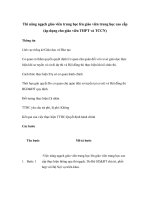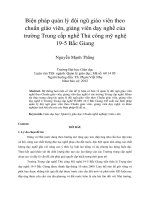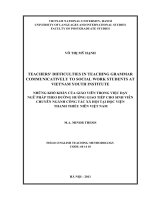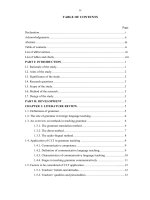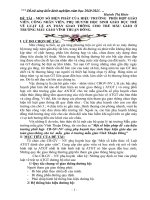Năng lực tự học vai trò của giáo viên và bạn bè LEARNER AUTONOMY: THE ROLES OF TEACHERS AND PEERS
Bạn đang xem bản rút gọn của tài liệu. Xem và tải ngay bản đầy đủ của tài liệu tại đây (1.6 MB, 319 trang )
MINISTRYOFEDUCATIONANDTRAININGHOCHIMINHCITYOP
ENUNIVERSITY
LEHATOQUYEN
LEARNERAUTONOMY:THEROLESOFTEACHERSANDPEERS
PHILOSOPHYINTEACHINGENGLISHTOSPEAKERSOFOTHERLANGUA
GESDOCTORALDISSERTATION
HOCHIMINHCITY,2023
ii
MINISTRYOFEDUCATIONANDTRAININGHOCHIMINHCITYOP
ENUNIVERSITY
LEHATOQUYEN
LEARNERAUTONOMY:THEROLESOFTEACHERSANDPEERS
Major:PhilosophyinTeachingEnglishtoSpeakersofOtherLanguages
Code:9140 111
DOCTORALDISSERTATION
HOCHIMINHCITY,2023
STATEMENTOFAUTHORSHIP
The Doctoral Dissertation titled“Learner Autonomy: The Roles of Teachers
andPeers”has been submitted for the degree of Doctor of Philosophy in Teaching
Englishto SpeakersofOther Languages.
Except for the references cited in this dissertation, I hereby declare that the whole
orpartsofthis dissertationhavenotbeenpublishedorusedtoobtainthedegreeelsewhere.
No other person'swork/research may be used in this thesis that isn o t p r o p e r l y
c i t e d . This thesis has never been submitted for any degree at any other university or
traininginstitution.
HoChiMinhCity,…/…/2023.
LeHaToQuyen
2
ACKNOWLEDGEMNENTS
“Learner Autonomy: The Roles of Teachers and Peers” Doctoral Dissertation has
beencompleted at HoChiMinhCityOpenUniversity.
I take this opportunity to extend my heartfelt thanks and deep gratitude to all those
whohave contributed to the successful completion of this thesis. Their continuous
support,guidance,andencouragementhavebeeninstrumentalinmyacademicjourney.
Firstandforemost,Iwouldliketoexpressmysinceregratitudetomyscientificsupervisors,
Ms.BuiThi Thuc Quyen, Ph.D.and Mr.Dang TanTin, Ph.D.Theircomprehensive
knowledge, unwaverings u p p o r t , a n d e n t h u s i a s t i c g u i d a n c e h a v e
b e e n the cornerstone of my research. Their insights and intellectual stimulation have
beeninvaluable to my growth and understanding of the subject matter. I am forever
indebtedto themfortheirrolesin myachievement.
IamalsodeeplythankfultotheGraduateLecturersatHoChiMinhCityOpenUniversity. Their
extensive
expertise
and
generous
provision
of
background
knowledgehavesignificantlyenrichedmystudyactivities.
I must also extend my appreciation to my family, relatives, colleagues, classmates,
andfriends. Their belief in me and constant encouragement have fortified me during
thechallenges and pressures of this endeavor. Without their support and love, this
journeywould havebeenfarmorearduous.
Finally, I acknowledge all others who have contributed in any way to this
project,whether directly or indirectly. The collaborative spirit I have experienced will
stay withmeascherishedmemories.
Inclosing,Ireflectonthisjourneywithprofoundappreciationforthecollectivewisdom,guidance,
and
support
the
that
have
made
this
thesis
a
reality.
It
is
my
hope
that
workpresentedherehonorstheeffortsandcontributionsofallthosementionedabove.
HoChiMinhCity,…./…/2023
ABSTRACT
Learner autonomy has been considered the central aim of education because of
itssignificant role in enabling students to develop into successful lifelong learners.
Inmodern times, students have many opportunities to learn outside the classroom, the
idealcontextforlearnerautonomydevelopment. Therefore,researchaboutthedevelo
pmentof
learner
autonomy
in
the
out-of-class
learning
context
needs
to
receive
more
focus.Basedonsocioculturaltheoryasthetheoreticalframework,thecurrentr e s e a r c h explo
res the situation of EFL tertiary students’ learner autonomy in the out-of-classcontext
and thepotential of promoting it through teachers’ and peers’ rolesin theclassroom.
With the explanatory sequential mixed methods designs, the study collecteddata from
answers to a questionnaire on learner autonomy and teachers’ and peers’ roles(N=709)
andsemi-structuredin-depth
groupinterviews(N=35).
Thef i n d i n g s
p o i n t e d outthatalthoughstudentshadamoderatecapacitytocontrolthes i t u a t i o n a l ,
behavioural, and psychological dimensions of learner autonomy, they still faced
manychallenges when learning independently. In addition, there were significant
correlationsbetween factors of the situational, behavioural, and psychological
dimensions
of
learnerautonomyandtherolesofteachersasaresource,anevaluator,acontroller,aninstructor,afaci
litator,andaco-learnerintheclassroom.Themediatingfactorsofthesecorrelations were the
students’
motivation,
role
model,
trust,
and
care.
In
addition,
thecorrelationsbetweenlearnerautonomyandthefourperceivedpeers’rolesintheclassroom:
acolearner,anencourager,anassessor,andasupporterwerealsosignificant.Themediatingfactors
ofthesecorrelationswerepositiveemotions,interdependence, responsibilities, and face
value. The research findings have providedempirical data about EFL tertiary students’
learner autonomy in the out-of-class contextand the connection between in-class and
out-of-class learning. These findings providepedagogical implications for learners,
teachers,
and
peers
classlearningcontext.
to
foster
learner
autonomydevelopmentintheout-of-
TABLEOFCONTENTS
TABLEOF CONTENTS..................................................................................................i
LISTOFABBREVIATIONS........................................................................................vii
LISTOFFIGURES.......................................................................................................viii
LISTOFTABLES............................................................................................................ix
LISTOFAPPENDICES..................................................................................................xi
Chapter1...........................................................................................................................1
INTRODUCTION...........................................................................................................1
1.1. Generalcontextofthe study.....................................................................................1
1.1.1. ThehistoryofEnglishteachingandlearninginVietnam......................................2
1.1.2. Thevital roleofEnglishinVietnamesecontext..................................................3
1.1.3. ThechallengesofEnglishtraininginVietnamesecontext....................................5
1.1.4. EnglishtraininginVietnamhighereducation......................................................8
1.2. Rationale of theresearch........................................................................................11
1.3. Researchaims,objectivesandresearchquestions....................................................13
1.4. Significanceoftheresearch....................................................................................14
1.5. Scopeof theresearch..............................................................................................14
1.6. Definition ofkeyterms...........................................................................................15
1.7. Thesisorganisation................................................................................................15
1.8. Chapter overview..................................................................................................17
Chapter2.........................................................................................................................18
LITERATUREREVIEW..............................................................................................18
2.1. Learnerautonomy..................................................................................................18
2.1.1. Conceptualisation oflearnerautonomy...........................................................18
2.1.1.1. Generalconceptionsoflearnerautonomyinlanguageteaching.................18
2.1.1.2. Modelsoflearner autonomy.....................................................................21
2.1.1.3. Operationaldefinitionoflearnerautonomy................................................25
2.1.2. Theimportanceoflearner autonomy...............................................................26
2.1.3. Degreesoflearnerautonomy............................................................................28
2.1.4. Factorsthatinfluencethedevelopmentoflearnerautonomy.............................29
2.1.5. Approachestofosterlearnerautonomy.............................................................32
2.1.6. Learnerautonomyinout-of-classlearning........................................................34
2.2. Perceivedteachers’rolesinthelanguageclassroom.................................................38
2.2.1. Acontroller......................................................................................................40
2.2.2. An instructor...................................................................................................42
2.2.3. Afacilitator......................................................................................................43
2.2.4. Aco-learner.....................................................................................................44
2.2.5. Aresource........................................................................................................45
2.2.6. An evaluator....................................................................................................46
2.2.7. An explorer.....................................................................................................47
2.3. Perceivedpeers’rolesinthelanguageclassroom.....................................................48
2.3.1. Aco-learner.....................................................................................................49
2.3.2. Asupporter......................................................................................................50
2.3.3. An encourager.................................................................................................51
2.3.4. An assessor.....................................................................................................52
2.4. Theoreticalframework...........................................................................................53
2.4.1. Constructivismandsocial constructivism........................................................53
2.4.2. SCT.................................................................................................................54
2.4.3. CoP..................................................................................................................57
2.5. Learnerautonomyandperceivedteachers’roles......................................................59
2.5.1. Perceivedteachers’rolesinlearnerautonomydevelopmentactivity...............59
2.5.2. Mediatingfactorsoflearnerautonomyandperceivedteachers’roles..............60
2.6. Learnerautonomyandperceivedpeers’roles..........................................................61
2.6.1. Perceivedpeers’rolesinlearnerautonomydevelopmentactivities.................61
2.6.2. Mediatingfactorsbetweenlearnerautonomyandperceivedpeers’roles......62
2.7. Previousstudiesandresearchgap............................................................................64
2.8. Theconceptualframeworkofthe study..................................................................67
2.9. Chapter overview..................................................................................................69
Chapter3.........................................................................................................................70
METHODOLOGY........................................................................................................70
3.1. Research paradigm................................................................................................70
3.2. Research design.....................................................................................................71
3.3. Thequantitativeresearch........................................................................................75
3.3.1. Objectives.......................................................................................................75
3.3.2. Participants......................................................................................................75
3.3.2.1. Rationale forchoosingEnglishmajors......................................................75
3.3.2.2. Samplesize................................................................................................76
3.3.2.3. Samplingmethod......................................................................................76
3.3.3. Instrumentdevelopment..................................................................................78
3.3.3.1. Rationaleforchoosingthequestionnaireformat.........................................78
3.3.3.2. Questionnairedesign.................................................................................79
3.3.3.3. Questionnaireproofreading......................................................................86
3.3.3.4. Translating thequestionnaire....................................................................87
3.3.3.5. Piloting thequestionnaire..........................................................................88
3.3.4. Quantitativedatacollectionprocedure.............................................................89
3.3.5. Quantitativedatamanagement.........................................................................90
3.3.6. Quantitativeanalysis.......................................................................................92
3.3.7. Issuesofreliabilityandvalidityofthequantitativeresearch...............................96
3.4. Thequalitativeresearch..........................................................................................96
3.4.1. Objectives.......................................................................................................97
3.4.2. Rationaleforadoptingsemi-structuredin-depthgroupinterview....................97
3.4.3. Participantsandtherecruitmentprocess............................................................97
3.4.4. Instrument.....................................................................................................100
3.4.4.1. Instrumentdesign....................................................................................100
3.4.4.2. Piloting theinterviewprotocol................................................................101
3.4.5. Qualitativedatacollectionprocedure.............................................................101
3.4.6. Qualitativedataanalysis.................................................................................102
3.4.7. Thetrustworthinessofqualitativedata............................................................103
3.5. Ethicalconsiderations.........................................................................................105
3.6. Chaptersummary...............................................................................................107
Chapter4.......................................................................................................................108
DATAANALYSIS.......................................................................................................108
4.1. Resultsofthequantitativephase.........................................................................108
4.1.1. Demographici n f o r m a t i o n .........................................................................108
4.1.2. EFLstudents’learnerautonomyinout-of-classlearning.........................109
4.1.2.1. Internalconsistencyreliabilitymeasureoflearnerautonomyscale...109
4.1.2.2. Descriptivestatisticsoflearnerautonomy............................................110
4.1.3. Perceivedteachers’rolesinthelanguageclassroom...................................115
4.1.3.1. ExploratoryFactorAnalysis(EFA)oftheP e r c e i v e d t e a c h e r s ’ r o l
e s scale................................................................................................................115
4.1.3.2. Descriptivestatisticsofperceivedteachers’roles................................119
4.1.4. Perceivedpeers’rolesintheclassroom.........................................................122
4.1.4.1. ExploratoryFactorAnalysisofPerceivedpeers’rolesscale................122
4.1.4.2. Descriptivestatisticsofperceivedpeers’roles.....................................125
4.1.5. Correlationsbetweenlearnerautonomyandperceivedteachers’roles....127
4.1.5.1. Pearsoncorrelationsbetweenlearnerautonomyandperceivedteachers’
roles 127
4.1.5.2. Canonicalcorrelation between
learnera u t o n o m y a n d p e r c e i v e d teachers’roles.................................130
4.1.6. Correlationsbetweenlearnerautonomyandperceivedpeers’roles..........133
4.1.6.1. Pearsoncorrelationsbetweenlearnerautonomyandperceivedpeers’roles
133
4.1.6.2. Canonicalcorrelationbetweenlearnerautonomyandperceivedpeers’rol
es
137
4.2. Resultsofthequalitativeresearch......................................................................140
4.2.1. Mediatingfactorsoflearnerautonomyandperceivedteachers’roles........141
4.2.2.1. Motivationasamediatingfactor.............................................................141
4.2.2.2. Trustasamediatingfactor......................................................................143
4.2.2.3. Rolemodelasamediatingfactor.............................................................145
4.2.2.4. Careasamediatingfactor........................................................................146
4.2.2. Mediatingfactorsoflearnerautonomyandperceivedpeers’roles.............147
4.2.2.1. Positiveemotionsasamediatingfactor.................................................148
4.2.2.2. Interdependenceasamediatingfactor...................................................149
4.2.2.3. Responsibilitiesasamediatingfactor....................................................150
4.2.2.4. Facevalueasamediatingfactor..............................................................151
4.3. Chapteroverview...............................................................................................153
Chapter5.......................................................................................................................154
FINDINGSANDDISCUSSIONS..............................................................................154
5.1. EFLtertiarystudents’learnerautonomyinout-of-classlearning...................154
5.1.1. Thesituationaldimension...........................................................................154
5.1.2. Thebehaviouraldimension.......................................................................157
5.1.3. Thepsychological dimension...................................................................160
5.2. Perceivedteachers’rolesintheclassroom..........................................................161
5.3. Perceivedpeers’rolesintheclassroom...............................................................164
5.4. Learnerautonomyandperceivedteachers’roles..............................................166
5.4.1. Correlationsbetweenlearnerautonomyinout-ofclasslearningandperceivedteachers’rolesintheclassroom.................................166
5.4.2. Mediatingfactorsofcorrelationsbetweenlearnerautonomyinout-ofclasslearningandperceivedteachers’rolesintheclassroom................................167
5.5. Learnerautonomyandperceivedpeers’roles...................................................171
5.5.1. Correlationsbetweenlearnerautonomyinout-ofclasslearningandperceivedpeers’rolesintheclassroom......................................171
5.5.2. Mediatingfactorsofcorrelationsbetweenlearnerautonomyinout-ofclasslearningandperceivedpeers’rolesintheclassroom......................................173
5.6. Finalisingtheresearchmodel..............................................................................176
5.7. Chapteroverview...............................................................................................177
Chapter6.......................................................................................................................178
CONCLUSIONANDIMPLICATIONS.................................................................178
6.1. Summary.............................................................................................................178
6.1.1. EFLtertiarystudents’learnerautonomyinout-of-classlearning............179
6.1.2. Correlationsbetweenlearnerautonomyandperceivedteachers’rolesandtheir
mediatingfactors..................................................................................................180
6.1.3. Correlationsbetweenlearnerautonomyandperceivedpeers’rolesandtheirm
ediatingfactors.......................................................................................................181
6.2. Contributionsofthestudy.....................................................................................181
6.3. Pedagogicali m p l i c a t i o n s ...............................................................................183
6.3.1. Policymakers...............................................................................................183
6.3.2. Institutions....................................................................................................183
6.3.3. Teachers........................................................................................................185
6.3.3.1. Autonomysupportintheclassroom.......................................................185
6.3.3.2. Peerc o l l a b o r a t i o n ..............................................................................186
6.3.4. Learners........................................................................................................187
6.4. Limitations..........................................................................................................188
6.5. Directionsforfurtherresearch............................................................................189
6.6. Concludingsentence..........................................................................................189
REFERENCES............................................................................................................191
APPENDICES..............................................................................................................223
7
LISTOFABBREVIATIONS
CEFR
CommonEuropeanFrameworkofReferenceforLanguages
CoP
CommunityofPractice
EFL
EnglishasaForeignLanguage
HCMC
HoChiMinhCity
IELTS
InternationalEnglishLanguageTestingSystem
L1
FirstLanguage
LBC
LearningBeyondtheClassroom
LMS
LearningManagementSystem
MoET
MinistryofEducationandTraining
SAC(s)
Self-AccessedCentre(s)
SCT
SocioculturalTheory
TOEIC
TestofEnglishforInternationalCommunication
ZPD
ZoneofProximalDevelopment
LISTOFFIGURES
Figure2.1T h e operationaldefinitionoflearnerautonomy.........................................26
Figure2.2Theconceptualframeworkofthestudy..........................................................68
Figure4.1ScreeplottestwithEigenvaluesgreaterthan1ofthesecondEFArunonperceive
dteachers’roles.............................................................................................................117
Figure4.2ScreeplottestwithEigenvaluesgreaterthan1ofsecondEFArunonperceivedpee
rs’roles..........................................................................................................................123
Figure4.3CanonicalCorrelationAnalysisbetweenperceivedteachers’rolesandlearner
autonomy.......................................................................................................................133
Figure 4. 4Canonical CorrelationA n a l y s i s b e t w e e n p e r c e i v e d p e e r s ’
r o l e s a n d learnerautonomy....................................................................................139
Figure5.1Researchfinalmodel...................................................................................176
LISTOFTABLES
Table2.1Rolesofteachersinthelanguageclassroom.....................................................40
Table3.1Researchdesign..............................................................................................74
Table3.2Overviewofthequestionnaire........................................................................80
Table3.3Detailedinformationofthescaleswiththeadaptedsources.............................85
Table3.4Extractofthedescriptivestatisticsofquantitativedata...................................94
Table3.5Descriptionofparticipantsinthequalitativeresearch...................................99
Table4.1Demographicinformationoftheparticipants.............................................109
Table4.2C r o n b a c h ’ s alphavaluesofnineconstructsoflearnerautonomyscale 109
Table4.3D e s c r i p t i v e statisticsofthesituationaldimensionoflearnerautonomy1 1
0
Table4.4E x t r a c t ofthedescriptivestatisticsofthebehaviouraldimension.........112
Table4.5E x t r a c t ofthedescriptivestatisticsofthepsychologicaldimension......114
Table4.6K M O andBartlett’sTestofthesecondEFArunonperceivedteachers’roles116
Table4.7ExtractofthetotalvarianceexplainedofthesecondEFArunonperceivedteache
rs’roles...........................................................................................................................117
Table4.8ExtractoffactorloadingsofthesecondEFArunonperceivedteachers’roles 118
Table4.9C r o n b a c h ’ s Alphavaluesofperceivedteachers’rolesconstructs....119
Table4.10E x t r a c t ofthedescriptivestatisticsofperceivedteachers’roles.........121
Table4.11K M O andBartlett’sTestofthesecondEFArunonperceivedpeers’roles
.....................................................................................................................................123
Table4.12ExtractofthetotalvarianceexplainedofsecondEFArunonperceivedpeers’ro
les...................................................................................................................................123
Table4.13E x t r a c t offactorloadingsofthesecondEFArunonperceivedpeers’ro
les...................................................................................................................................124
Table4.14C r o n b a c h ’ s Alphavaluesofperceivedpeers’roles.........................125
Table4.15D e s c r i p t i v e statisticsofperceivedpeers’roles...............................126
Table4.16P e a r s o n correlationsbetweenfactorsoflearnerautonomyinthesituat
ionaldimensionandperceivedteachers’roles.............................................................128
Table4.17E x t r a c t ofPearsoncorrelationsbetweenfactorsoflearnerautonom
yinthebehaviouraldimensionandperceivedteachers’roles......................................129
Table4.18Pearsoncorrelationsbetweenfactorsoflearnerautonomyinthepsychological
dimensionandperceivedteachers’roles.....................................................................130
Table4.19Canonicalcorrelationsbetweenfactorsofperceivedteachers’rolesandlearn
erautonomy...................................................................................................................131
Table4.20V a r i a b l e s ofCanonicalVariate1........................................................132
Table4.21P r o p o r t i o n ofvarianceexplainedofCanonicalVariate1................132
Table4.22P e a r s o n correlationsbetweenfactorsoflearnerautonomyinthesituat
ionaldimensionandperceivedpeers’roles..................................................................134
Table4.23P e a r s o n correlationsbetweenfactorsoflearnerautonomyinthesituat
ionaldimensionandperceivedpeers’roles..................................................................136
Table4.24Pearsoncorrelationsbetweenfactorsoflearnerautonomyinthepsychologicaldi
mensionandperceivedpeers’roles..............................................................................137
Table4.25Canonicalcorrelationsofperceivedpeers’rolesandlearnerautonomy.137
Table4.26CanonicalVariate1loadings.......................................................................138
Table4.27Proportion ofvarianceexplainedofCanonicalVariate1.........................138
Table4.28Summaryofthemesandsub-themesgeneratedfromdataanalysis............140
Table4.29ExtractofSummarytableofMotivationasamediatingfactorsub-theme
.....................................................................................................................................142
Table4.30ExtractofSummaryofTrustasamediatingfactorsub-theme.....................144
Table4.31ExtractofSummaryofRolemodelasamediatingfactorsub-theme...........145
Table4.32ExtractofSummaryofCareasamediatingfactorsub-theme......................147
Table4.33ExtractofSummaryofPositiveemotionsasamediatingfactorsub-theme
.....................................................................................................................................149
Table4.34ExtractofSummaryofInterdependenceasamediatingfactorsub-theme
.....................................................................................................................................150
Table4.35ExtractofSummaryofResponsibilitiesasamediatingfactorsub-theme
.....................................................................................................................................151
Table4.36E x t r a c t ofSummaryofFacevalueasamediatingfactorsub-theme......152
LISTOFAPPENDICES
Appendix3AUniversityparticipantinvitationletter.................................................223
Appendix3BListofquestionnaireitemsandadaptedsources......................................225
Appendix3CQuestionnaireinEnglish.......................................................................230
Appendix3DQuestionnaireinVietnamese...............................................................236
Appendix3EInterviewprotocol.................................................................................243
…………………………………………………………………………………………..Appen
dix3FDescriptivestatisticsoflearnerautonomy,perceivedteachers’roles,andperceivedp ee r
s ’ r o l e s ..................................................................................................246
Appendix4APerceivedteachers’rolesintheclassroom.............................................253
Appendix4BPerceivedpeers’rolesintheclassroom...................................................261
Appendix4CCorrelationsbetweenlearnerautonomyandperceivedteachers’roles
.....................................................................................................................................266
Appendix4DCorrelationsbetweenlearnerautonomyandperceivedpeers’roles...268
Appendix4EMediatingfactorsbetweenlearnerautonomyandperceivedteachers’roles
.......................................................................................................................................268
Appendix4FMediatingfactorsbetweenlearnerautonomyandperceivedpeers’roles
.....................................................................................................................................268
Appendix4GInterviewtranscript–GroupInterview1(inEnglish)............................271
1
Chapter
1INTRODUCTIO
N
Learner autonomy hasbeen a centrala i m
students
of
education
because
w i t h higher learner autonomy can accomplish better and be more
confident in their life-longlearning. In language training, learner autonomy has also
been in the mainstream ofresearch for more than three decades. However, it remains a
complicated
concept
thatrequiresmoreempiricaldatatostrengthentheunderstandingofitselfanditsrelationshipsw
ithotherfactors.
Research into students’ learner autonomy is of even greater importance in the
contextofVietnam,adevelopingcountrywhoseeducationisundertheinfluenceofConfucianis
mwhichrequiresobediencetoregulators’dictationandchallengesforstudents’
independence. The current study is designed to understand EFL (English as aForeign
Language) students’ learner autonomy in the out-of-class context by exploringthe
correlations between it and two influcing factors, teachers and peers, contributing tothe
knowledge of this dynamic construct. The following section of this chapter presentsan
overview of the study, starting with a description of the study context, then proposingthe
researchrationaleandpointingouttheresearch’sobjectivesandquestions.Italsohighlights the study’s significance before
addressing the study’s limitations and theorganizationof thethesis.
1.1. Generalcontextofthestudy
Vietnam is a developing country whose history was heavily related to fighting
forindependence. Its turbulenthistory explained why differentforeign languages
weretaught in the country. This section describes English’s role in society, the learning
andteaching process of English, especially at the tertiary level, and the challenges
thateducators and learners face. This piece of information will set up the context of
thestudy.
1.1.1. ThehistoryofEnglishteachingandlearninginVietnam
The foreign languages taught in Vietnam throughout history have reflected
itssocio-political and economic frameworks (Le, 2013). English has been held in
highregardsincethecountryembarkedonitseconomicreformknownasDoiMoi(Renovation)
in
1986
(Ngo,
2021).
The
history
of
English
language
teaching
in
Vietnamundergoesthesemainmilestones: before1954,1954-1975,19751986,andfrom1986tothepresent.
In the first period, foreign language teaching was under the influence of
controlledcountries.MandarinChinesewas
thefirstforeignlanguageinVietnamduringtheChineseoccupationandinfluenceperiod.After
that,thesixdecadesofFrenchcolonialism from 1884 to 1945 made French the second
primary
foreign
language
taughtinschoolsinVietnam.EnglishalsomadeitsfirstpresenceinVietnamasaminorforeignlanguage
(Hoang,2020a).
AftertheendoftheFrenchcolonizationandfrom1954to1975,Vietnamwasdividedinto two parts –
the
North
and
the
South,
and
each
part
was
allied
with
different
worldsuperpowers.TheSovietUnionprovidedeconomicassistancetoNorthVietnam;meanwh
ile, the United States began to replace France as the principal foreign power
inSouthVietnam.Thesupport
fromtheSoviet
UnionandAmericaninvolvementinVietnamaddedRussianandEnglishtothechoicesofforei
gnlanguagestaughti n schoolsbesidesChineseandFrench.Notably,theNorthpromotedlearningRussianandChinese, and
the
South
emphasized
the
study
of
English
and
French
as
the
main
foreignlanguagesinsecondaryandpost-secondaryeducation(Hoang,2010).
After the end of the Vietnam War and the independence of the country from 1975
to1986, Russian was the language that dominated the foreign language scene in
Vietnam;other foreign languages, such as Chinese, French, and especially English,
were relegatedto an inferior status (Hoang, 2020a). In 1986, Vietnam initiated an overall economicreform commonly
known as Doi Moi (Renovation), opening the door of Vietnam to theworld, especially
to Western and non-Communist Asian countries. The implementationoftheopendoorpolicyhasstronglysupportedtheteachingandlearningofEnglishas
asignificantforeignlanguage,turningittobecomethekeytointernationalcommunication.
Additionally,
Vietnam
joined
different
internationalo r g a n i z a t i o n s
i n theregionandallovertheworld,suchastheUnitedNations(UN)in1977,theAssociationofSoutheast
AsianNations(ASEAN)in1995,theAsia-Pacific EconomicCooperation (APEC) in 1998, the World Trade
Organization (WTO) in 2007, the Trans-PacificStrategicEconomicPartnershipAgreement(TPP)in2015.In2009,
ASEANformallymadeEnglishthesoleworkinglanguageforthegroup.
It can be said that this economic renovation has elevated English competence to
acrucial interlink within the global economy, transforming language skills into
economiccapital(H o le c, 1 9 8 1 ) . T h i s trans formation h a s pos itioned E n g l i s h p r o
f i c i e n c y n o t j u s t as a linguistic skill but as a strategic asset in global economic participation. Singh et al.(2002,pp.5354)underscore thisbystatingthat enhancing citizens’competenceinEnglish is viewed as
“a way of securing economic advancement, elevated status andprestige,andtransnationalmobilityofacountry.”Consequently,inVietnam,proficiency in English is not
only a widespread aspiration but is also integral to thenation’s economic development,
modernisation, and global integration. Post-1986, withthe onset of the Doi Moi
reforms,
English
has
become
the
dominant
foreign
language
intheVietnameseeducationsystem,playingapivotalroleinshapingthecountry'seducationall
andscapeanditsinternationalengagements.
1.1.2. ThevitalroleofEnglishinVietnamesecontext
Good English hasbecomethe passport towell-paid jobs in Vietnam and
theadvancededucationsystemsofprestigiousuniversitiesworldwide.Aqualifiedworkforce
withgoodEnglishskillsistheconditionforthenation’seconomicdevelopment in the era of
industrialization and globalization. Because of its vital role,many legal documents from
the MinistryofE d u c a t i o n
and
importance
students’
of
improving
Training
English
(MoET)
levels.
The
s t r e s s e d the
Government’s
VietnameseEducation Strategies document stated that one of the essential attributes that
Vietnamesestudentsm u s t p o s s e s s i s E n g l i s h c o m p e t e n c y ( V i e t n a m e s e G
overnment,2005).The
Vietnamese Education Law required that the foreign language taught in the
nationaleducationsystembe“widelyusedininternationalcommunication”(VietnameseNati
onal Assembly, 2005, p. 2). In 2008, the approval of the National Foreign
LanguageProject entitled “Teaching and Learning Foreign Languages in the National EducationSystem, Period 20082020” (with a budget of up to 450 million US dollars) proved thatEnglish teaching and
learning is one of the priorities in the government’s investmentstrategies and education
policies (Vietnamese Government, 2008). The Project specifiedEnglishastheforeignlanguagetaughtat
alleducationlevelsinVietnam.ItstatedthatVietnamese students need to acquire a certain level of English
after completing eacheducation level to communicate and work in a global working
environment
(VietnameseGovernment,
2008).
Even
though
in
the
framework
of
the
VietnameseC o n s t i t u t i o n 2013, English was a foreign language with six other foreign
languages, it has a specialstatus, second only to Vietnamese - the national language - in
terms of time and trainingoutcomes. The vital role of English is displayed in its
dominant status in a student’slearningprocessinVietnam.
Vietnamese people try to improve their English as early as possible. The age to
startlearning English is getting younger and younger for Vietnamese children. They
typicallyenterpreschoolfromthreetofiveyearsoldandcanhavetheirfirstcontactwithEnglishduring this time, depending
on the parent’s needs. English is an optional part of thetraining program in certain
kindergartens in affluent areas of big cities. After preschool,children transfer to primary
school,where they attendfromagesix to eleven.OnDecember 26, 2018, MoET issued the
two-year optional curriculum entitled GeneralSchool Education Introductory English
Curriculum for Grades 1 and 2, with two periodsper week and seventy periods per year (MoET, 2018c).
Secondaryschoolyearsaredivided into lower secondary and higher secondary education. Lower
secondary lastsfour years, whereas higher secondary lasts three years. The General
School
EducationCurriculum
nationallyas
school
through
a
(GSEC)
compulsory
upper
requiredEnglisht o
be
taught
s u b j e c t for seven years from lower
secondary
school
with
a
total
numberofs e v e n h u n d r e d p e r i o d s ( f o u r h u n d r e d p e r i o d s m o r e t h a n i t w a s f r o m
1982to2002
